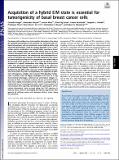| dc.contributor.author | Kröger, Cornelia | |
| dc.contributor.author | Afeyan, Alexander | |
| dc.contributor.author | Mraz, Jasmin | |
| dc.contributor.author | Eaton, Elinor Ng | |
| dc.contributor.author | Reinhardt, Ferenc | |
| dc.contributor.author | Thiru, Prathapan | |
| dc.contributor.author | Bierie, Brian | |
| dc.contributor.author | Ye, Xin | |
| dc.contributor.author | Weinberg, Robert A | |
| dc.date.accessioned | 2020-07-23T15:15:09Z | |
| dc.date.available | 2020-07-23T15:15:09Z | |
| dc.date.issued | 2019-04 | |
| dc.identifier.issn | 0027-8424 | |
| dc.identifier.uri | https://hdl.handle.net/1721.1/126342 | |
| dc.description.abstract | Carcinoma cells residing in an intermediate phenotypic state along the epithelial–mesenchymal (E–M) spectrum are associated with malignant phenotypes, such as invasiveness, tumor-initiating ability, and metastatic dissemination. Using the recently described CD104+/CD44hi antigen marker combination, we isolated highly tumorigenic breast cancer cells residing stably—both in vitro and in vivo—in an intermediate phenotypic state and coexpressing both epithelial (E) and mesenchymal (M) markers. We demonstrate that tumorigenicity depends on individual cells residing in this E/M hybrid state and cannot be phenocopied by mixing two cell populations that reside stably at the two ends of the spectrum, i.e., in the E and in the M state. Hence, residence in a specific intermediate state along the E–M spectrum rather than phenotypic plasticity appears critical to the expression of tumor-initiating capacity. Acquisition of this E/M hybrid state is facilitated by the differential expression of EMT-inducing transcription factors (EMT-TFs) and is accompanied by the expression of adult stem cell programs, notably, active canonical Wnt signaling. Furthermore, transition from the highly tumorigenic E/M state to a fully mesenchymal phenotype, achieved by constitutive ectopic expression of Zeb1, is sufficient to drive cells out of the E/M hybrid state into a highly mesenchymal state, which is accompanied by a substantial loss of tumorigenicity and a switch from canonical to noncanonical Wnt signaling. Identifying the gatekeepers of the various phenotypic states arrayed along the E–M spectrum is likely to prove useful in developing therapeutic approaches that operate by shifting cancer cells between distinct states along this spectrum. | en_US |
| dc.description.sponsorship | National Institutes of Health (U.S.) (Grant R01 CA078461) | en_US |
| dc.description.sponsorship | National Institutes of Health (U.S.) (Grant U01 CA184897) | en_US |
| dc.language.iso | en | |
| dc.publisher | Proceedings of the National Academy of Sciences | en_US |
| dc.relation.isversionof | 10.1073/PNAS.1812876116 | en_US |
| dc.rights | Article is made available in accordance with the publisher's policy and may be subject to US copyright law. Please refer to the publisher's site for terms of use. | en_US |
| dc.source | PNAS | en_US |
| dc.title | Acquisition of a hybrid E/M state is essential for tumorigenicity of basal breast cancer cells | en_US |
| dc.type | Article | en_US |
| dc.identifier.citation | Kröger, Cornelia et al. “Acquisition of a hybrid E/M state is essential for tumorigenicity of basal breast cancer cells.” Proceedings of the National Academy of Sciences of the United States of America, vol. 116, no. 15, 2019, pp. 7353-7362 © 2019 The Author(s) | en_US |
| dc.contributor.department | Whitehead Institute for Biomedical Research | en_US |
| dc.contributor.department | Massachusetts Institute of Technology. Department of Biology | en_US |
| dc.contributor.department | Massachusetts Institute of Technology. Division of Comparative Medicine | en_US |
| dc.contributor.department | Ludwig Center for Molecular Oncology (Massachusetts Institute of Technology) | en_US |
| dc.relation.journal | Proceedings of the National Academy of Sciences of the United States of America | en_US |
| dc.eprint.version | Final published version | en_US |
| dc.type.uri | http://purl.org/eprint/type/JournalArticle | en_US |
| eprint.status | http://purl.org/eprint/status/PeerReviewed | en_US |
| dc.date.updated | 2019-12-02T13:12:25Z | |
| dspace.date.submission | 2019-12-02T13:12:31Z | |
| mit.journal.volume | 116 | en_US |
| mit.journal.issue | 15 | en_US |
| mit.metadata.status | Complete | |
